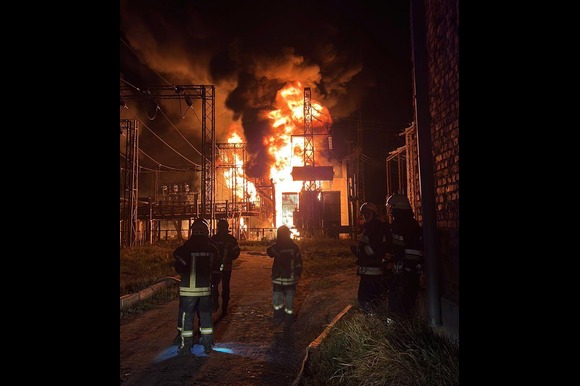
By National Police of Ukraine
Russia: Residents in Russia’s Belgorod region say blackouts, air-raid sirens and the crackle of gunfire targeting incoming Ukrainian drones have become an almost daily ordeal, as Kyiv steps up cross-border attacks in retaliation for Moscow’s unrelenting strikes on Ukrainian cities.
“It’s so loud and terrifying,” says Nina, a Belgorod resident who asked that her name be changed for safety reasons. “I was coming back from the clinic when the sirens went off. As usual, I received alerts on Telegram about a drone attack. Then came bursts of gunfire. I ran into a nearby courtyard and tried to hide under an arch.”
“The next day it all happened again — air defence fire, automatic gunfire, explosions.”
An analysis by BBC News Russian, based on official regional data, shows that the number of Ukrainian drone attacks on Belgorod has risen nearly fourfold since the start of 2025. In January, about 1,100 drones were recorded in the region. By September, that figure had soared to over 4,000.
One of the largest strikes took place last month, when officials said more than 260 drones targeted the region in a single day. Missile attacks have also grown more frequent since the summer months.
Ukraine, meanwhile, continues to endure far heavier losses from Russia’s near-daily missile and drone bombardments, which regularly kill civilians and plunge towns into freezing darkness. Overnight into Wednesday, Russian strikes killed at least seven people — including two children — in Ukrainian cities. Authorities in Kyiv warn that the coming winter may prove the most punishing yet.
Ukrainian officials say the surge in attacks on Belgorod, some of which have caused massive power cuts, is a direct response to Russia’s latest assault on Ukraine’s energy grid.
“Maybe they should stop being too comfortable there in Belgorod?” Ukrainian President Volodymyr Zelensky said earlier this month. “They must understand: if they want to leave us without power, then we will do the same.”
Belgorod, situated near the Ukrainian border, is a vital logistical corridor and staging hub for Russian troops. It is also a regular launch site for artillery and short-range drone attacks across the border.
While smaller towns in the region have faced power outages before, the city of Belgorod itself had largely been spared until this autumn. That changed on the evening of 28 September, says local student Ekaterina (not her real name).
“I was at home when the notifications started popping up on my phone: ‘Missile alert! Take shelter!’” she recalls. “The sirens began to howl, and the lights in my flat started flickering. Then came the explosions — very loud. The lights blinked and went out.”
Local Telegram channels later reported that missiles had struck the city’s main heat and power plant, as well as a nearby substation. Power was restored quickly in central Belgorod, but suburban areas remained without electricity overnight. Across the region, around 77,000 people — roughly 5% of the population — were still without power the next morning.
“While you’re in an office in the city centre, you might not even notice the blackout,” says another resident, Natalya, who also asked not to be identified. “But once you head home, it’s like entering a completely different world — total darkness. Apartment blocks are dark, shops are dark. You can’t even see your bus stop.”
Less than a week later, another major blackout hit the city. Local authorities admit they lack the capacity to provide backup generators for everyone, urging residents to purchase their own.
“But what are we supposed to fuel them with, given the fuel crisis?” asks Maria, an elderly resident.
More than half of Russia’s regions — including Belgorod — are suffering petrol and diesel shortages, following a series of Ukrainian strikes on oil refineries. The shortages have driven up both fuel and generator prices.
Ukrainian forces have ramped up production of their “Darts” drones — light, inexpensive models capable of carrying 4kg (9lb) warheads. Residents believe the increased use of these drones is behind the surge in attacks. The drones can be launched individually or in swarms, potentially overwhelming Russian air defences.
However, analysts say that the recent attacks on Belgorod’s energy infrastructure likely involved heavier weapons. Reports suggest that long-range Himars rockets or Morok drones equipped with larger payloads may have been used.
For many Russians, the war still feels remote — but not for Belgorod residents. Here, its impact is tangible and relentless.
“Until September, it felt like the war had faded into the background again,” says Yakov, another resident who declined to give his real name. “But now, we’re constantly reminded of it — through power outages, fuel shortages, and this general sense of anxiety.”
He pauses, then adds quietly: “I have a strong feeling that by continuing this war, Russia is racing headlong toward the abyss.”




